
Understanding Your Backyard Giants
Introduction
Have you ever stopped to truly appreciate the trees in your backyard? These majestic giants are much more than just shade providers. They’re complex living organisms with intricate biological processes, fascinating roles in the ecosystem, and even the ability to communicate with each other. In this blog post from Treecology LLC, we’ll delve into the fascinating world of trees, exploring their internal workings, ecological contributions, and the unique ways they interact with their environment. By understanding your backyard giants better, you can learn to appreciate them more, care for them properly, and even benefit from their presence.
The Inner Workings of a Tree
Beneath the bark lies a hidden world brimming with activity. Trees, like humans, have a vascular system that transports vital fluids throughout their structure. Xylem, the “wood” of a tree, carries water and dissolved minerals from the roots to the leaves. Phloem, on the other hand, transports sugars produced in the leaves through photosynthesis down to the roots and other growing parts of the tree.
Leaves are the “factories” of a tree, where sunlight, water, and carbon dioxide are converted into energy-rich sugars through photosynthesis. Tiny pores on the leaves called stomata allow for gas exchange, taking in carbon dioxide for photosynthesis and releasing oxygen, a vital component of the air we breathe.
The roots of a tree play a crucial role in anchoring it to the ground, absorbing water and nutrients, and even communicating with neighboring trees. Recent research suggests that trees can send signals through a network of fungal threads in the soil, sharing information about threats like disease or drought.
The Ecological Importance of Trees:
Trees are the lungs of our planet, responsible for absorbing vast amounts of carbon dioxide, a major greenhouse gas, and releasing life-giving oxygen. They play a critical role in regulating climate and combatting climate change.
Beyond climate regulation, trees offer a multitude of ecological benefits. They provide habitat for countless species of animals, insects, and birds. Their leaves filter rainwater, preventing soil erosion and promoting healthy ecosystems. They also help regulate water flow, preventing floods and replenishing groundwater reserves. The shade cast by trees reduces heat stress in urban areas and creates a cooler microclimate.
Understanding Your Trees: Signs of Health and Distress:
Learning to identify signs of health and distress in your trees is crucial for their long-term well-being. Healthy trees have full, green canopies, strong branches, and a robust trunk.
Signs of distress can include:
- Thinning or discolored leaves
- Dead branches
- Cracks or wounds in the bark
- Mushrooms or fungal growth at the base of the tree
If you notice any of these signs, it’s best to consult a certified arborist for professional assessment and treatment. Early intervention can save your tree and ensure its continued contribution to your landscape.
Conclusion:
Trees are truly remarkable organisms, offering beauty, environmental benefits, and even a glimpse into the interconnectedness of nature. By understanding their inner workings and ecological importance, we can appreciate them more, care for them with knowledge, and reap the many benefits they provide.

